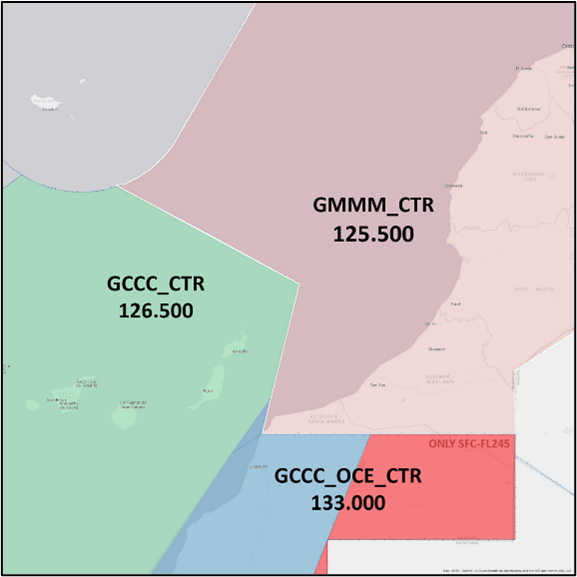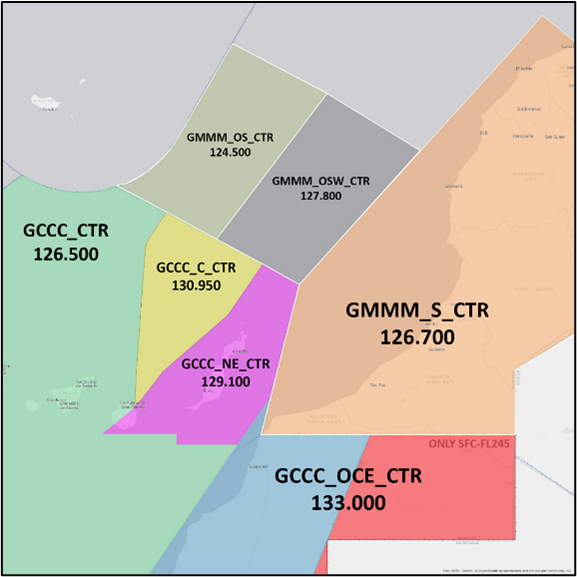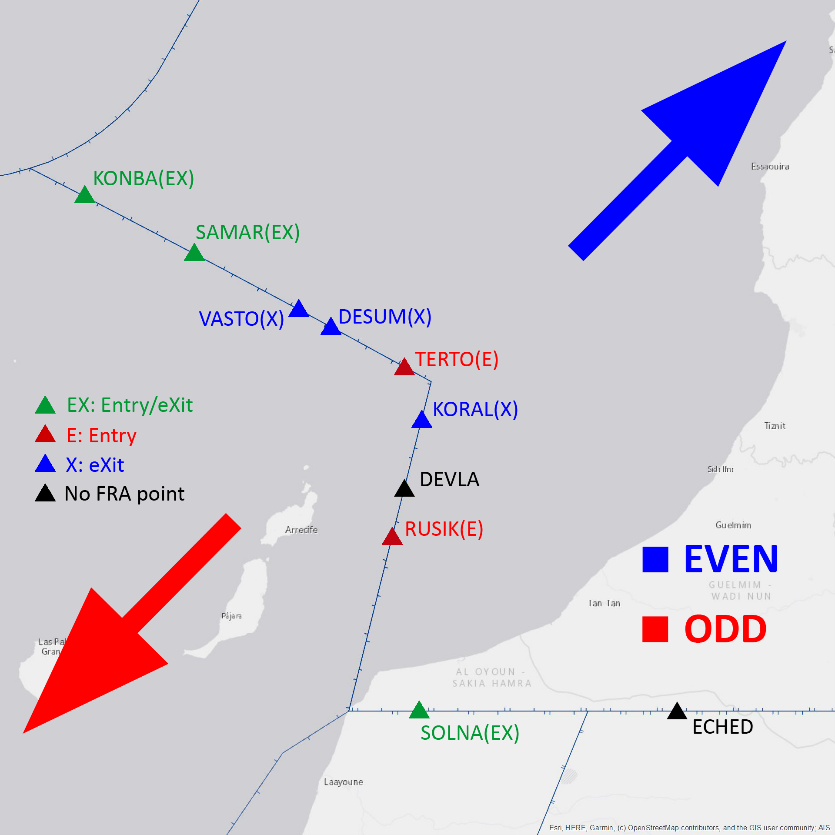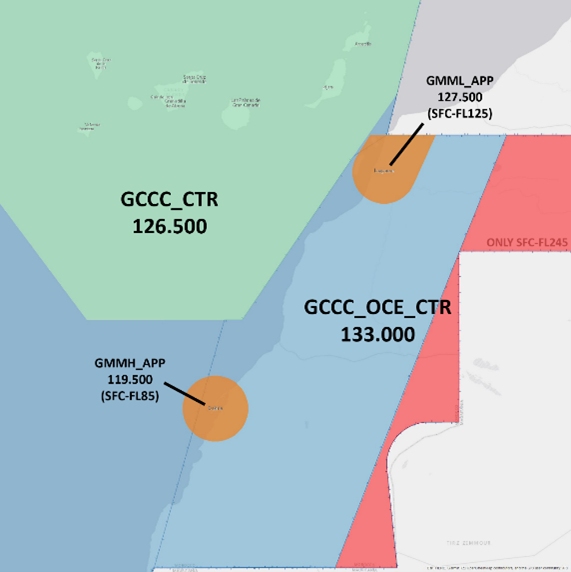Canarias ACC (GCCC) and Casablanca ACC (GMMM)
1. Purpose
The purpose of this Letter of Agreement (LoA) is to define the coordination procedures to be applied between Casablanca ACC and Canarias ACC when providing Air Traffic Services (ATS) under IFR or VFR flight rules.
The content of the agreement is approved by the concerned ATC Operations Department and FIR Chiefs and its application is mandatory for all IVAO members providing ATS within an active position concerned by this LoA.
2. General Procedures
Traffic in sequence at the same flight level shall be handed over with minimum spacing of 10 NM.
This separation must be constant (aircrafts restrained to the same speed) or increasing (succeeding aircraft is not faster).
Coordination of speed control should be granted via entries in radar labels and does not need neither approval nor acknowledgement by receiving sector.
Traffic shall be handed over as soon as practical and, whenever possible, at latest 3000 ft before reaching the cleared flight level and in case the transfer point is not defined within this LoA, at latest ten (10) miles before the airspace limits.
Traffic in sequence shall be handed over properly separated and clear of any conflict. The receiving ATC unit cannot issue a clearance modifying the traffic’s route, altitude, or speed (unless by direct coordination between ATC units) until it enters his sector and therefore leaves the area of responsibility from the transferring ATC unit, which remains responsible for separation.
Regarding flight levels for transfers between ATC positions:
|
From |
To |
Flight Level (1) |
|
Canarias |
Casablanca |
EVEN |
|
Casablanca |
Canarias |
ODD |
(1) Exceptions listed in section 4
Free Route Airspace Operations within Spanish airspace (HISPAFRA) is defined in Canarias (FRA CELL 2) from FL305 to FL660. However, the use of the traditional ATS route network is compatible with HISPAFRA.
Free Route Airspace (FRA) is a specified airspace within which users may freely plan a route between a defined entry point and a defined exit point, with the possibility of routing via published intermediate significant points, without reference to the ATS route network.
3. ATS Unit Description
The ATC unit in charge of Canarias airspaces under the responsibility of Canarias ACC is Canarias Control and consists in one main sector (GCCC_CTR) and two secondary sectors (GCCC_NE_CTR, GCCC_C_CTR). The lateral and vertical boundaries of the airspace under the responsibility of the ACC are indicated below.
GCCC_CTR, GCCC_NE_CTR and GCCC_C_CTR can be consolidated on one main sector (GCCC_CTR).
The ATC unit in charge of Casablanca airspaces under the responsibility of Casablanca ACC is Casablanca Control and consists in one main sector (GMMM_CTR) and three secondary sectors (GMMM_OS_CTR, GMMM_OSW_CTR, GMMM_S_CTR).
The lateral and vertical boundaries of the airspace under the responsibility of the ACC are indicated in the images and tables below.
3.1. Canarias ACC
|
ATC Position |
Callsign |
Frequency |
Remarks |
|
Primary sectors |
|||
|
Canarias Control |
GCCC_CTR |
126.500 |
SFC-FL660 |
|
Canarias Control (Oceanic) |
GCCC_OCE_CTR |
133.000 |
SFC-FL660 (Partly SFC-FL245) |
|
Secondary Sectors |
|||
|
Canarias Control (Northeast Sector) |
GCCC_NE_CTR |
129.100 |
SFC-FL660 (NOTAM req) |
|
Canarias Control (Central Sector) |
GCCC_C_CTR |
130.950 |
SFC-FL660 (NOTAM req) |
3.2. Casablanca ACC
|
ATC Position |
Callsign |
Frequency |
Remarks |
|
Primary sectors |
|||
|
Casablanca Radar |
GMMM_CTR |
125.500 |
SFC-FL660 |
|
Secondary Sectors |
|||
|
Agadir Radar (Oceanic Sector) |
GMMM_OS_CTR |
124.500 |
SFC-FL660 |
|
Agadir Radar (Oceanic Sector) |
GMMM_OSW_CTR |
127.800 |
SFC-FL660 |
|
Agadir Radar (South Sector) |
GMMM_S_CTR |
126.700 |
SFC-FL660 |
4. Coordination Procedures
Coordination procedures between the ATC under the responsibility of the Canarias ACC and those under the responsibility of the Casablanca ACC are defined as follows. They represent a general framework that does not replace the coordination between ATC. Any coordination procedure not mentioned in this LoA must be established on a case-by-case basis. Both units shall keep each other advised about relevant VFR flights.
FRA Horizontal Entry Point (E) is a published Significant Point on the horizontal boundary of the Free Route Airspace from which FRA operations are permitted while an Exit Point (X) is a Point to which FRA operations are permitted.
Entry and Exit points are shown here from the perspective of Canarias FRA Cell (GCCC ACC).
4.1. From Canarias to Casablanca (GCCC → GMMM)
|
Transfer Point |
Route |
Receiving Sector |
Flight Level |
|
|
Airways |
HISPAFRA (2) |
|||
|
ECHED (1) |
UT975 |
- |
GMMM_S_CTR |
EVEN |
|
DESUM |
- |
X (eXit)
FL>305 |
GMMM_OSW_CTR |
|
|
KONBA |
UN602 J602 UN866 |
GMMM_OS_CTR |
||
|
KORAL |
UN871 G5 |
GMMM_S_CTR |
||
|
SAMAR |
UN873 |
GMMM_OS_CTR |
||
|
SOLNA (1) |
A600 UL660 |
GMMM_S_CTR |
||
|
VASTO |
UN858 |
GMMM_OSW_CTR |
||
(1) See section 4.3 for especial consideration
(2) Free Route Airspace Operations within Spanish airspace (HISPAFRA) is defined in Canarias from FL305 to FL660
4.2. From Casablanca to Canarias (GMMM → GCCC)
|
Transfer Point |
Route |
Receiving Sector |
Flight Level |
|
|
Airways |
HISPAFRA (2) |
|||
|
DEVLA |
G850 UG850 |
- |
GCCC_NE_CTR |
ODD |
|
ECHED (1) |
UT975 |
GCCC_CTR |
||
|
KONBA |
UN866 |
E (Entry)
FL>305 |
GCCC_CTR |
|
|
RUSIK |
- |
GCCC_NE_CTR |
||
|
SAMAR |
UN873 |
GCCC_C_CTR |
||
|
SOLNA (1) |
A600 UL660 |
GCCC_OCE_CTR |
||
|
TERTO |
A857 UN857 |
GCCC_NE_CTR |
||
(1) See section 4.3 for especial consideration
(2) Free Route Airspace Operations within Spanish airspace (HISPAFRA) is defined in Canarias from FL305 to FL660
4.3. Routes via SOLNA and ECHED
It is critical to understand that GCCC_OCE_CTR does not have radar-service. This ATC position controls aircraft conventionally using position reports and time-based separation.
Therefore:
- Traffic flying via SOLNA or ECHED shall be time-based separated.
- If two aircrafts fly at the same altitude within the same route, they will be separated with 10 minutes if the preceding aircraft is faster or at the same speed as the aircraft following.
- Additionally, if the preceding aircraft is maintaining a Mach number greater than the following aircraft, the following time-based separation criteria may apply:
- 9 minutes separation, if the preceding aircraft is Mach 0.02 faster than the following aircraft.
- 8 minutes separation, if the preceding aircraft is Mach 0.03 faster than the following aircraft.
- 7 minutes separation, if the preceding aircraft is Mach 0.04 faster than the following aircraft.
- 6 minutes separation, if the preceding aircraft is Mach 0.05 faster than the following aircraft.
- 5 minutes separation, if the preceding aircraft is Mach 0.06 faster than the following aircraft.
Note: When using Mach-number speed control, pilots shall be instructed to report their assigned Mach number to the accepting ATS Unit upon initial contact.
5. Departures and Arrivals
5.1. Arrivals to GCRR
Traffic destination GCRR via DEVLA will be descending to FL210 without prior coordination.
Traffic destination GCRR via TERTO can be vectored or cleared direct to PEPOM descending FL250 in trail with a minimum spacing of 10 NM and speed control applied. These traffics shouldn’t cross the common border more than 15 NM west of TERTO.
5.2. Arrivals to GCFV
Traffic destination GCFV via RUSIK will be descending to FL210 without prior coordination.
5.3. Departures from GCRR/GCFV
Traffic departing from GCRR and GCFV via DESUM (inbound GMMM) shall not be cleared to climb above FL320.
6. Special Procedures
If the accepting ATS unit cannot accept a flight offered in accordance with the conditions stated in this document, it shall clearly indicate its inability and specify the conditions under which the flight will be accepted.
In cases where a traffic not approved for RVSM is flying through RVSM airspace, coordination between ACC’s with regard to the flight level appropriate for the transfer of the traffic have to take place.
6.1. Longitudinal Separation Based on Time and Radar-Observed Distance
Transfer of control of the aircraft on the same track or crossing tracks, whether at the same level, climbing or descending, may be affected provided that a minimum longitudinal separation of 3 minutes exists between aircraft, the relevant aircraft are continuously flight path monitored and the transferring ATS Unit has ensured that the actual distance between the aircraft does not reduce to less than 20 NM.
7. Sahara
|
ATC Position |
Callsign |
Frequency |
Remarks |
|
Canarias |
|||
|
Canarias Control |
GCCC_CTR |
126.500 |
SFC-FL660 |
|
Canarias Control (Oceanic) |
GCCC_OCE_CTR |
133.000 |
SFC-FL660 (Partly SFC-FL245) |
|
Sahara |
|||
|
Laayoune Approach |
GMML_APP |
127.500 |
SFC-FL125 |
|
Laayoune Tower |
GMML_TWR |
131.100 |
- |
|
Dakhla Approach |
GMMH_APP |
119.500 |
SF-FL85 |
|
Dakhla Tower |
GMMH_TWR |
118.100 |
- |
Important Note: Laayoune ATC and Dakhla ATC should inform GCCC_OCE_CTR every time a traffic intends to depart the airport. Estimated Take Off Time should be informed to GCCC_OCE_CTR.
Canarias ATC will inform GMML/GMMH ATC about arriving traffic with the Estimated Landing Time.
GCCC_OCE_CTR (or GCCC_CTR if Eastbound) will transfer traffic to GMML_APP cleared to FL130.
GMML_APP will transfer traffic to GCCC_OCE_CTR (or GCCC_CTR if Westbound) cleared to FL120.
GCCC_OCE_CTR will transfer traffic to GMMH_APP cleared to FL090.
GMMH_APP will transfer traffic to GCCC_OCE_CTR cleared to FL080.
If there is no ATC connected at GMML or GMMH, Canarias ATC will not provide ATC service at these airports. In this case GCCC_OCE_CTR will release the traffic to Unicom (122.800) descending through FL130 (GMML) or FL90 (GMMH).
Departing traffic shall contact GCCC_OCE_CTR once approaching FL120 (GMML) or FL80 (GMMH).
8. Contributions
This document has been drafted in coordination between the ATC Operations Department of Spain and Morocco and Canarias FIR.
9. Changelog
|
Version |
Date |
Changes |
|
1.1 |
30/12/2021 |
Initial release |
|
1.2 |
14/03/2022 |
Transfer FL’s at TERTO Renaming of GCCO_CTR to GCCC_OCE_CTR Added Table “Specific Points for Transfer of Control and Transfer of communications” |
|
2.0 |
21/4/2022 |
New format Implementation of Free Route Airspace in Spain (HISPAFRA) |



